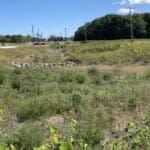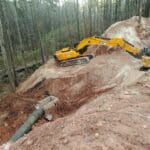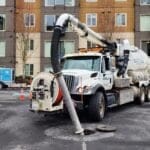City of Birmingham / County of Jefferson
The County of Jefferson has enacted a Stormwater Ordinance in order to establish minimum stormwater management requirements and controls to protect and safeguard the general health, safety, and welfare of the public residing in watersheds within this jurisdiction. The County of Jefferson is the permitting authority for all land disturbing activities and requires the land owner to maintain all on-site stormwater control facilities and all open space areas (e.g. parks or “green” areas) required by the approved stormwater control plan. The County of Jefferson will only provide construction permits to projects that establish a plan to manage stormwater runoff occurring during the construction process. The County of Jefferson, under the NPDES program, also has the authority to inspect properties for noncompliance and can issue a notice of violation (NOV) for any deficiency or infraction onsite. Property owners are responsible for the maintenance of any stormwater facilities or practices located on the property. The County of Jefferson has the authority to inspect stormwater facilities and practices in order to ascertain that they are properly maintained and functioning.
Birmingham Code of Ordinance
Sec. 4-9-34. – Stormwater management plan required.
(a) Each application for a post construction stormwater permit shall be accompanied by three sets of stormwater management plans as set forth in section 4-9-36, and any other required, supporting forms and certifications prepared and signed by the appropriate professional.
(b) Each request for termination of a post construction stormwater permit shall be accompanied by two sets of stormwater record drawings, as set forth in section 4-9-38, and any other required supporting forms and certifications prepared and signed by the appropriate professional.
(c) Additional plans or reports may be required by the director to allow adequate assessment of the proposed stormwater designs, to better understand potential flood, drainage, or pollutant impacts of a proposed or installed stormwater drainage system.
Sec 4-9-36- Stormwater Management Plan Standards
(c) Performance standards, technical methods, required calculations, and post construction stormwater practice design specifications that are applied to prepare the stormwater management plan shall be in accordance with the design manual. Technical methods, calculation approaches, or practices not shown in the design manual shall not be used without prior written permission of the director. This chapter shall supersede where the regulations of this chapter and the policies stated in the design manual conflict.
(d) The stormwater management plan shall be subject to any additional requirements as set forth in city subdivision regulation, zoning ordinance, engineering and construction specifications, public work specifications, and all other city regulations.
(e) It is the responsibility of the owner to be aware of, and to fully address, any regulations or permits that may apply to his/her land development, including state and federal regulations for construction activities that will have an impact on Waters of the State, wetlands, sinkholes, landslide areas, and threatened or endangered species. The director may require proof of land development conformance with, or coverage by, any applicable local, state, or federal regulation or permit in the stormwater management plan.
Sec. 4-9-83. – Post construction maintenance and integrity.
(a) It shall be the responsibility of the owner(s) of land developments to:
(1) At all times operate and maintain the individual and collective stormwater drainage systems and post construction stormwater practices located on their property, whether or not such systems and practices are identified on the property’s plat, in proper, functional condition as defined by the approved stormwater management plan and the maintenance manual;
(2) Inspect and maintain all post-construction stormwater practices located on their property in accordance with the maintenance manual;
(3) At all times protect said systems and practices from alteration that adversely impacts their function as indicated by the approved stormwater management plan;
(4) Perform corrective actions when conditions occur that can or do adversely impact the function of the said systems and practices, whether said actions are undertaken voluntarily by the owner or required by the director; and
(5) Keep records of inspection and maintenance activities for a period of at least three years and make them available to the director upon request.
(b) Removal of said systems and practices, or their alteration in any way that adversely impacts their approved function and performance standard, without the prior approval of the director is expressly prohibited.
(c) The responsibilities stated herein shall continue for the owner(s) of land developments until such time that ownership of the property is transferred, upon which these responsibilities are immediately transferred to the subsequent owner.
Sec. 4-9-84. – Annual post construction owner inspection.
Owner(s) of post construction stormwater practices shall, at a minimum, inspect and document said practices annually to ensure the practices are properly functioning and compliant with this chapter. More frequent inspections may be required to ensure proper function, as established by the maintenance manual based on the maintenance needs of specific types of practices or by director as he/she deems necessary to ensure the maintenance needs of a particular practice are being addressed. Inspections shall be conducted by a person familiar with the operation of said practices on the property and be documented and submitted to the director in the manner established in the maintenance manual.
Sec. 4-9-103. – Notice of violation.
(a) Whenever the director finds a violation of a prohibition or a failure to meet a requirement of this chapter or a failure to comply with a warning notice, the director may order compliance by written notice of violation.
(b) This notice of violation shall contain:
(1) The name and address of the alleged violator, property owner, and/or operator;
(2) The address of the premises (when available) or a description of the building, structure, land, individual and collective stormwater drainage system and/or post construction stormwater practice upon which the violation is occurring or has occurred;
(3) A statement specifying the nature of the violation;
(4) A description of the corrective action(s) necessary to restore compliance with this chapter and a deadline for the completion of said action(s);
(5) A statement of the penalty or penalties that shall or may be assessed against the person to whom the notice of violation is directed;
(6) A statement that the determination of violation may be appealed to the stormwater appeals board, by filing a written notice of appeal with the director within ten business days of service of a notice of violation; and
(7) A statement specifying that, should the violator fail to restore compliance with this chapter within the established time schedule, the work will be done by a designated governmental agency or a contractor and twice the expense thereof shall be charged to the violator as allowed hereunder and collected as allowed by law.
Jefferson County Subdivision and Construction Ordinance
ARTICLE 13 – EROSION AND SEDIMENTATION
13.10 General.
All persons engaged in any land-disturbing activities shall take all reasonable measures to protect all public and private property, including roadways and waterways, from damage by such activities. However, that notwithstanding, there are certain specific measures that must be taken any time there is significant disturbance of the land; and the following provisions set forth the requirements that shall accordingly be imposed on persons engaged in land disturbing activities which necessitate planning and implementation of effective erosion and sedimentation controls for development sites.
13.31 Basic Control Objectives.
The basic control objectives which should be considered in developing and implementing an erosion and sedimentation control plan are to:
-
- Identify Critical Areas. On-site areas which are subject to severe erosion, and off-site areas which are especially vulnerable to damage from erosion and/or sedimentation caused from increased run-off are to be identified and receive special attention.
- Limit Exposed Areas. All land-disturbing activities should be planned and conducted to minimize the size of the area to be exposed at any one time.
- Limit Time of Exposure. To the maximum extent practicable, all land-disturbing activities should be planned and conducted to limit exposure to the shortest feasible time.
- Control Surface Water. Surface water runoff originating upgrade of exposed areas should be controlled to reduce erosion and sediment loss, to the maximum extent practicable, during the period of exposure.
- Control Sedimentation. All land-disturbing activities should be planned and conducted so as to prevent offsite sedimentation damage.
- Manage Storm Water Runoff. When the increase in storm water volumes, peak rates and/or velocity of storm water runoff resulting from a land-disturbing activity is sufficient to cause damaging accelerated erosion of the receiving ditch or channel stream, plans should include measures to help control the velocity and/or rate of release so as to minimize accelerated erosion and increased sedimentation of the ditch or stream channel. This may include the use of outlet energy dissipaters, detention methods, ditch or instream channel measures or engineered controls.
- Low Impact Development Techniques. Erosion and sedimentation control plans should seek to incorporate low impact development and environmental site design techniques, such as infiltration and capture/re-use of storm water, to the maximum extent practicable.
13.40 Commencement of Land-Disturbing Activities:
Responsibilities of the Property Owner/Developer.
No land-disturbing activity subject to the provisions and requirements of this Article shall be undertaken except in accordance with the following mandatory processes and procedures. Persons conducting land-disturbing activities shall take all reasonable measures referred to, or provided for, in this Article to protect all public and private property from damage caused by such activities, and to reduce storm water pollution to the maximum extent practicable.
f. The person engaged in or conducting the land-disturbing activity shall be responsible for maintaining all temporary and permanent erosion and sedimentation measures and facilities during the development of a site. The responsibility for maintaining all permanent erosion and sedimentation control measures and facilities after site development is completed shall lie with the landowner, until such time as adequate vegetative cover and site stabilization is achieved as determined by the Director or his/her designee.
g. Control measures shall be maintained as an effective barrier to sedimentation and erosion in accordance with the provisions of this ordinance. All control measures shall be checked, and repaired as necessary, monthly in dry periods and within twenty-four (24) hours after any precipitation at the site of 0.75 inches or greater in any 24-hour period. During prolonged rainfalls, daily checking and, if necessary, repairing shall be done. The registrant of the erosion and sedimentation control plan shall maintain written records of such checks and repairs, which records shall be subject to inspection by Department personnel at any reasonable time.
h. There shall be no distinctly visible floating scum, oil or other matter contained in the storm water discharge. The storm water discharge to an MS4 must not cause any color (except dyes or other substances discharged to an MS4 for the purpose of environmental studies and which do not have a harmful effect on the bodies of water within the MS4) or odor in the community waters that does not occur naturally from normal ecological or biological processes in the environment. The storm water discharge to the MS4 must result in no materials in concentrations sufficient to be hazardous or otherwise detrimental to humans, livestock, wildlife, plant life or fish and aquatic life in the community waters.
k. Accidental Discharges.
-
- In the event of any discharge of a hazardous substance or a significant spill of a hazardous substance to the MS4 which could constitute a threat to human health or the environment, the owner or operator of the site shall give notice to the Department and the Jefferson County Emergency Management Authority in the same manner, and within the same time, as is required by State regulations for notice to ADEM.
- The owner or operator of such property shall take all reasonable steps to minimize any adverse impact to the community waters caused by discharges to the MS4, including such improved or additional monitoring as may be necessary to determine the nature and impact of the discharge. Absent a compelling public interest to the contrary, it shall not be a defense for the owner or operator in an enforcement action that it would have been necessary to halt or reduce the business or activity of the site, or any project or facility thereon, to maintain water quality and minimize any adverse impact that the discharge may cause.
13.50 Monitoring and Inspection of Land-Disturbing Activities:
Authority of the Department of Inspection Services
- The Director or his/her designee, bearing proper identification, may enter and inspect all land-disturbing activities for regular periodic inspections, investigations, monitoring, observations, measurements, enforcement, sampling and/or testing to verify compliance with the provisions of this ordinance, and to confirm the implementation and maintenance of any erosion and sedimentation control plan approved for such land disturbing activities.
- It is hereby further provided that any site undergoing land-disturbing activity shall be inspected when the Director or his/her designee believes, as a result of complaints or monitoring activity, that land-disturbing activities on the site are causing a substantial pollutant loading which threatens the MS4; or if the Director or his/her designee has reasonable cause to believe that discharges from a land-disturbing activity to the MS4 may cause an imminent threat to human health or the environment. Such inspections may take place at any time and without notice.
- Whenever the Department determines that significant sedimentation is occurring as a result of a land-disturbing activity, despite application and maintenance of protective practices, the person conducting the land-disturbing activity or the person responsible for maintenance will be required to take additional protective action, and to furnish this information to the Department.
- The Director or his/her designee shall inspect the site within five (5) working days after receipt of notice that the land-disturbing activity is finished, and stable vegetation or other permanent controls have been established on all remaining exposed soil, and may require additional measures to stabilize the soil and control erosion and sedimentation. If additional measures are so required, written notice of the requirement for such additional 143 – – measures shall be delivered to the owner, and the owner shall continue to be covered by the original registration issued until a final inspection approves the project as having been satisfactorily completed. The Director or his/her designee shall provide to the owner, within ten (l0) days of the date of such approval, a certification of completion showing that the requirements of the erosion and sedimentation control plan registration have been fulfilled
13.60 Enforcement and Abatement
- Unauthorized Discharges. Any discharge of storm water made in violation of this ordinance, or of any condition of an erosion and sedimentation control plan registered pursuant to this ordinance, shall be subject to correction and/or abatement in accordance with applicable law; provided, however, that the following direct or indirect discharges into the MS4 are allowable under the terms of this ordinance (unless determined by the Director or his/her designee to be a source of contamination to the community water): landscape irrigation; uncontaminated water from foundation and footing drains; discharges from springs; lawn watering; and discharges from fire fighting activities.
- Immediate Threats to Public Health or Welfare. Notwithstanding any other provision in this ordinance to the contrary, in the event of an immediate threat to the public health or welfare, the Director may take any and all appropriate measures to remove or alleviate such threat.
- Enforcement Authority. The Director or his/her designee shall have the authority to issue notices of violation and citations, and to designate those persons who have enforcement authority. In exercising that authority, the persons enforcing the requirements of this Article shall follow the policies and procedures outlined herein below.
1. Written Notice. Whenever an authorized employee of the Department finds that a registrant, or any other person discharging storm water, has violated or is violating this Article or the erosion and sedimentation control plan registered hereunder, the Department shall serve upon such person written notice of the violation. Within ten (10) days of such notice, the permit registrant/property owner shall submit to the Department a written explanation of the violation and a plan for the satisfactory correction and prevention thereof, including the specific action(s) to be taken. However, submission of said plan in no way relieves the discharger of liability for any violations occurring before or after receipt of the notice of violation.
8. Further Action. The Jefferson County Department of Inspection Services shall monitor all land-disturbing activities, including those approved under an ADEM NPDES permit, for compliance with the BMP/erosion and sedimentation control plan, and with all other applicable conditions or requirements as may have been made a part of said permit. The Department shall also be authorized to take whatever enforcement action may be necessary to bring a work site into compliance with said permit, as well as with all applicable requirements of this Article, to the fullest extent allowed by law. And, in any case where the Director determines that a non-compliant condition cannot or will not be satisfactorily addressed by the responsible parties, that enforcement action shall include the right for Jefferson County, or a designated agent of said County, to enter upon such non-compliant property (as provided in Section 13.30(f)); to carry out the work necessary to eliminate and/or prevent hazardous conditions, or erosion and/or sedimentation problems (as provided in Section 13.51); and to assess whatever penalties as may be deemed appropriate (under Section 13.61) by a court of law.
LINKS:
Birmingham Municipal Code
Jefferson County Subdivision & Construction Regulations
Jefferson County Stormwater Management Program Plan
 Kenosha, Wis. Highway KR Regenerative Stormwater ConveyanceThe Root-Pike Watershed Initiative Network Kenosha County, and others worked with AQUALIS to design and implement an innovative solution for stormwater control along Highway KR.
Kenosha, Wis. Highway KR Regenerative Stormwater ConveyanceThe Root-Pike Watershed Initiative Network Kenosha County, and others worked with AQUALIS to design and implement an innovative solution for stormwater control along Highway KR. Durham, N.C. Sinkhole Leads to Stormwater System RehabilitationThe tenant on this property noticed a depression that opened to the ground below and notified the property owners.
Durham, N.C. Sinkhole Leads to Stormwater System RehabilitationThe tenant on this property noticed a depression that opened to the ground below and notified the property owners.
